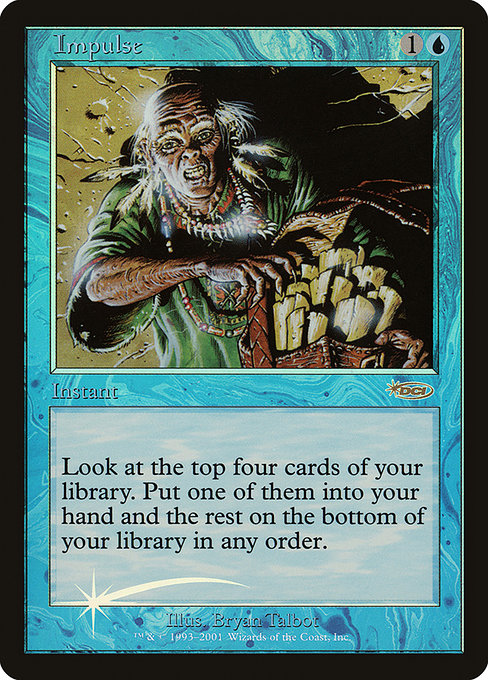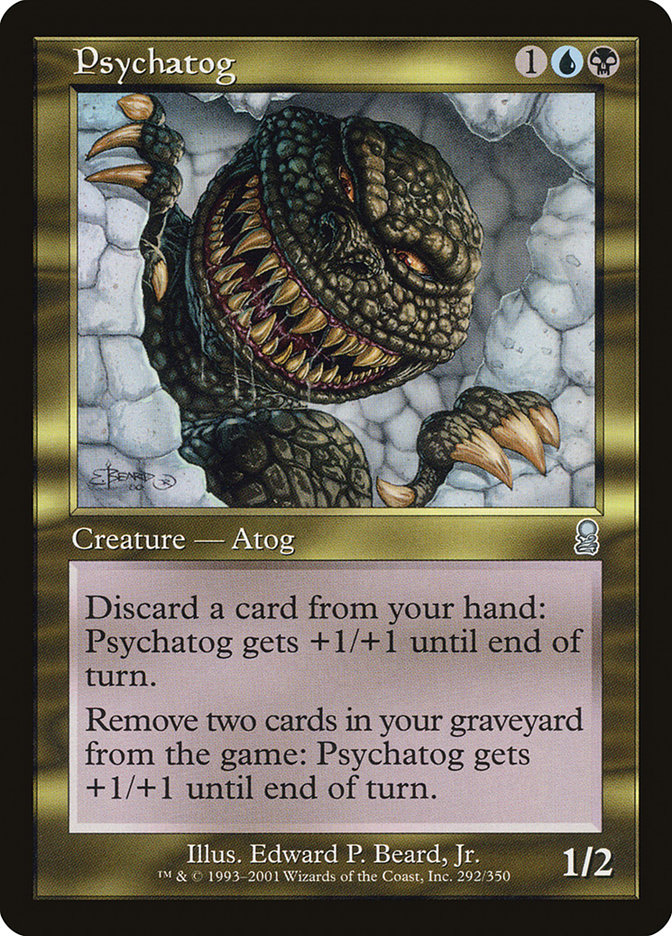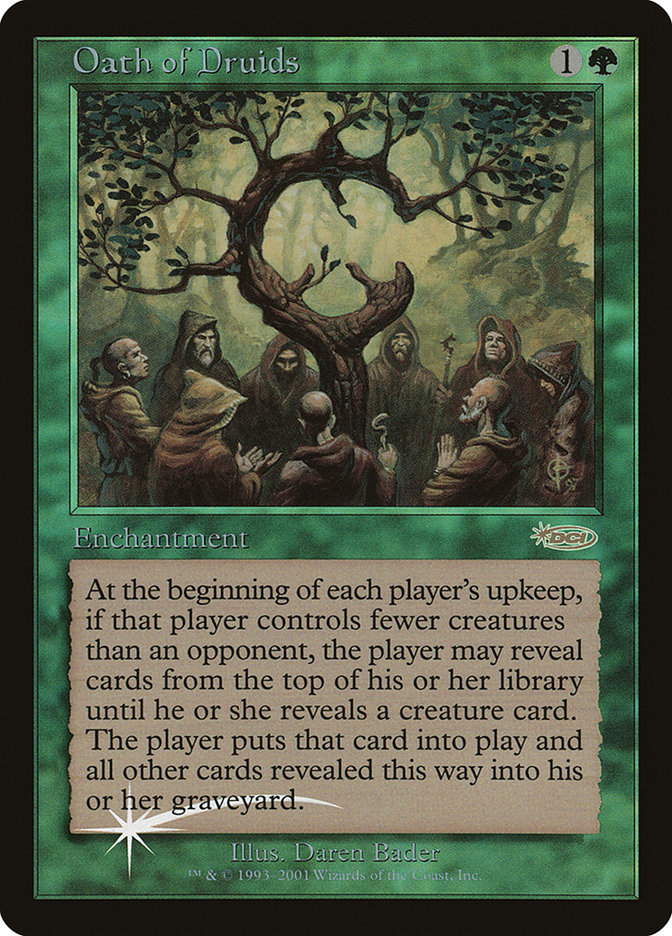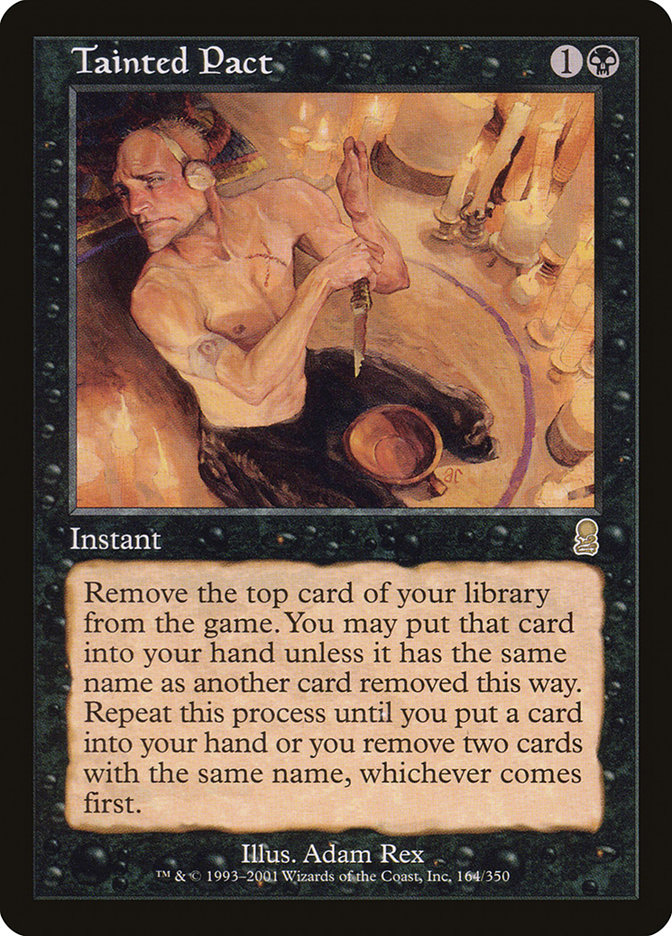Motivation
I have always been a big fan of the so called Xerox principle, I think it fits my playstyle very well and increases the consistency of my decks.
The Xerox terminology is also a bit obscure to some people in the community, in the sense that they don’t know what it means, which is normal because is not a broadly used concept in modern magic, even though is quite relevant in some formats, eg. Vintage.
I have been exploring Xerox in premodern for quite some time. I’ve had long conversations with Carlos Orellana about how important the role of cantrips is in some decks and, lately, also with Pietro de Sanctis and Rich Shay about Xerox in some Premodern decks. For this reason, I decided to share my thoughts and learnings about the concept with you.
TL; DR
- The Xerox principle: “For every four 1-2 mana cantrips in the deck, you can remove 2 lands”.
- Embracing the Xerox principle increases consistency of your draws at the cost of small tempo investment.
- I consider a deck “Xerox” if it plays 8 or more cantrips of cost 1 or 2, and I call this a Xerox shell.
- Blue based strategies are the best at Xerox, but you can apply it to any color.
- It works better in tempo and combo decks.
- You can transform some Premodern decks into Xerox decks.
What Is Xerox?
Some of you might have heard about this weird Xerox word in the Magic context, especially if you have been around the hobby for quite some time, and I’m sure that some of you also know what it means but for those who don’t have clarity about the term let me introduce you to the concept.
Back in 1997, Alan Comer took this piece of beauty to a second place in the Southern California Regional:
Turbo Xerox – Alan Comer
Main deck
4 Force of Will
3 Dissipate
4 Counterspell
4 Power Sink
4 Memory Lapse
4 Foreshadow
4 Portent
4 Impulse
4 Suq’Ata Firewalker
4 Waterspout Djinn
4 Man-o-War
1 Dream Tides
17 Island
Sideboard
1 Dissipate
1 Dream Tides
4 Hydroblast
3 Knight of the Mists
2 Sleight of Mind
4 Dandân
Today, the deck doesn’t seem revolutionary at all, it reminds a lot of Legacy Delver decks and, reality is that they have a lot in common.
The strategy behind the Turbo Xerox was to change lands for cantrips in order to virtually increase the threat count but also the land count of the deck.
The principle behind it is what we know today as the Xerox rule or principle:
“For every four 1-2 mana cantrips in the deck, you can remove 2 lands”.
As simple as that.
This leads us to two fundamental questions: what is a cantrip and where does the Xerox name come from?
What is a cantrip?
A cantrip is, by definition, a card that replaces itself in addition to its other effects.
A clear example of a signature premodern cantrip is Portent, which allows you to reorder the top three cards of either player’s deck and allows you to draw during the next upkeep phase.
Blue is typically the color with more density of cantrips, but cantrips can be found in any color in Magic. In premodern, you have Wall of Blossoms or Gaea’s Blessing as very common green cantrips, in red you can find Overmaster, white has Abeyance and in black you have cards like Tainted Pact or Phyrexian Rager, you can even find cantrips in the form of artifacts like Urza’s Bauble!
Even though the original Xerox principle refers to cantrips in general, the Xerox strategy tends to work better with card filtering cantrips like Portent, and the most efficient card filtering cantrips has historically been blue, and premodern is no exception.
As a side note, mind the difference between cantrips and card drawing engines. For instance, Gush and Accumulated knowledge are not cantrips, they are card drawing engines. The difference is that they just draw you cards and do nothing else, while cantrips, by definition, do something while replacing themselves.
Where does the Xerox name come from?
Well, the story tells that when Comer revealed his innovation, it created quite some hype. Before him, no one explored this strategy and it seemed to work very well that people started to copy his deck and explore the possibilities of the Xerox principle beyond the original 75.

Back then, one of the better known copy machine brands was, actually, Xerox, and due to its popularity and everyone copying Comer’s new deck it was named after this brand.
Why is it so good?
The Xerox principle has become very popular among mtg players in history since then. So much that Comer has a school of magic dedicated, and this is not by chance.
What the Xerox principle does is as simple as exchanging small amounts of tempo for card quality. This means that you can easily make your deck much more compact and adaptable to the actual gameplay. This is especially critical in tempo oriented strategies or very streamlined strategies that aim to look for specific cards to develop their gameplan, like combo decks. And, for this reason, Xerox decks tend to minimize their dead draws, improving their top decks on average.
Reality is, that taking the Xerox principle one step forward you can replace not only lands but also situational cards in your deck by card filtering cantrips obtaining a more streamlined game plan overall. For instance, you can remove one or two copies of your high end cards, the cards that are at the end of your curve and you want to see them at later stages of the game, to avoid drawing multiples in the early game and bury yourself in the potential value they would bring if drawn at the right time, but completely useless early on. Imagine you are playing Patriot and you start drawing multiple Fact or Fiction or Lightning Angels in turns 2 to 4, you may end up having trouble sequencing your threats. On the other hand if you run some cantrips instead of some of those cards you could simply spend little mana in filtering your draws to have a smoother transition from early to late game.
The lists below are examples of Patriot decks, one follows the Xerox principle (Patriot in a Xerox shell) and the other does not.
Patriot (not Xerox)
Main deck
3 Mother of Runes
4 Meddling Mage
2 Exalted Angel
4 Lightning Angel
3 Fact or Fiction
4 Lightning Bolt
4 Swords to Plowshares
3 Fire // Ice
4 Accumulated Knowledge
4 Mana Leak
1 Disenchant
4 Flooded Strand
3 Battlefield Forge
3 Shivan Reef
2 Gemstone Mine
3 Mountain
2 Plains
5 Island
2 Grand Coliseum
Sideboard
3 Tormod’s Crypt
2 Circle of Protection: Red
2 Pyroblast
1 Red Elemental Blast
1 Blue Elemental Blast
1 Hydroblast
3 Disenchant
2 Annul
Patriot (Xerox)
Main deck
4 Meddling Mage
2 Exalted Angel
4 Lightning Angel
3 Predict
3 Mana Leak
4 Memory Lapse
4 Lightning Bolt
4 Swords to Plowshares
3 Fire // Ice
3 Impulse
4 Portent
4 Flooded Strand
3 Battlefield Forge
3 Shivan Reef
2 Gemstone Mine
3 Mountain
2 Plains
5 Island
Sideboard
1 Exalted Angel
2 Tsabo’s Web
2 Warmth
2 Pyroblast
1 Red Elemental Blast
2 Blue Elemental Blast
1 Hydroblast
2 Disenchant
2 Annul

Does this mean that all the lists in premodern are better if they follow the Xerox principle? Well, the answer is no. It depends. Firstly, it depends on whether you have access to good quality cantrips, for instance it would be really challenging to build a good mono red Xerox list, but blue based strategies can make the best Xerox lists. Additionally, it depends on the game plan.
The Xerox principle relies on a decent quantity of “do nothing” cards to generate their card quality engine, if your plan is to outvalue the opponent using card advantage mechanisms, like in a control deck, you might be easily falling into a Xerox trap if you try to transform the structure of the deck; this is because control decks often tend to give away lots of tempo only to recover it by deploying a huge card advantage bomb (like Wrath of God, Pernicious Deed or Fact or Fiction), if you add small increments of tempo loss on top of that you might be falling behind too much to the point of no return.
On the contrary, if you are playing a full aggressive deck and you try to follow the Xerox principle you might be slowing your pace too much and losing the game consequently. This is because aggro decks, more than any other deck, rely on being ahead of tempo during the early game, which is where they win (or lose), and they normally have very few tools, or no tools at all, to recover the tempo loss, so every bit of tempo you give away it will never come back and this can be fatal.
In my opinion, the best strategies to develop a solid Xerox plan are tempo, combo and some midrange builds that can partially embrace it comfortably. This is because tempo decks are fully packed with tempo favorable cards that allow you to easily recover the initial tempo investment required by Xerox and combo decks just don’t care about the tempo loss if they can get their pieces together before reaching the critical level of 0 lives.
Xerox in premodern
We have some Premodern decks that fully embrace the Xerox principle. The first example that comes to mind is Gro-a-tog
Gro-a-tog
Main deck
4 Mox Diamond
2 Winter Orb
2 Psychatog
4 Meddling Mage
4 Quirion Dryad
4 Gush
4 Daze
2 Foil
4 Fire // Ice
4 Opt
2 Counterspell
3 City of Brass
4 Flooded Strand
6 Island
2 Polluted Delta
1 Undiscovered Paradise
1 Plains
4 Portent
3 Sleight of Hand
Sideboard
1 Winter Orb
2 Hydroblast
1 Blue Elemental Blast
3 Swords to Plowshares
2 Disenchant
1 Ray of Revelation
1 Red Elemental Blast
1 Pyroblast
1 Engineered Plague
2 Pyroclasm

Gro-a-tog current incarnations are mostly carbon copies to what they used to be in old extended. The plan is actually the same, win the game through incremental tempo advantages while you make your Dryad grow to unreachable levels or land a massive Psychatog. But remember, extended is not premodern and one of the fundamental differences the old extended lists faced was the lack of Swords to Plowshares in the format which made your main threats much more relevant. In premodern, we do have Swords to Plowshares around but that does not make the deck unplayable, we just need to be more cautious and make good use of Meddling Mage to protect our haymakers. But the plan is the same, land a massive threat; and the plan to achieve this is in perfect harmony with the Xerox principle. The deck plays no less than 15 cantrips (11 cost 1 and 4 cost 2) which allow the pilot to grow the Dryad quite fast while filling the graveyard of cards that might be later recycled as food for tog, no pun intended. At the same time, these cantrips allow the deck to be very light on mana and still operate efficiently.
Another list that we are used to seeing closely following the Xerox principle is U Stiflenought.
U Stiflenought
Main deck
4 Phyrexian Dreadnought
4 Gush
4 Foil
4 Daze
4 Counterspell
4 Vision Charm
4 Stifle
4 Impulse
4 Opt
4 Portent
2 Flash of Insight
1 Reality Ripple
1 Boomerang
16 Island
Sideboard
2 Cursed Totem
4 Annul
2 Hydroblast
2 Blue Elemental Blast
2 Boomerang
2 Null Rod
1 Winter Orb
U stiflenought plans to close the game as fast as possible by landing and protecting a nasty 12/12 trampling robot, and not by incrementally gaining tempo advantage as Gro-a-tog plans to do. However, both lists are structurally similar, in the sense that both make good use of low mana cost cantrips to make their land count and threat density more compact.
Besides these two lists, which we are all used to seeing following the Xerox principle, it is relatively easy to fine tune some other premodern stock lists to embrace the benefits of Xerox as we have seen above with Patriot.
As a rule of thumb, I consider a decklist to be a Xerox deck list if it plays at least 8 cantrips of CMC 1 or 2.
UB Xerox Psychatog
Main deck
4 Psychatog
1 Wonder
2 Counterspell
3 Circular Logic
3 Porhibit
3 Fact or Fiction
3 Gush
2 Smother
1 Ghastly Demise
2 Vendetta
1 Chain of Vapor
1 Boomerang
4 Duress
4 Portent
4 Impulse
4 Swamp
4 Polluted Delta
7 Island
4 Underground River
2 Flooded Strand
1 Cephalid Colisseum
Sideboard
2 Nevinyrral’s Disk
3 Engineered Plague
2 Hydroblast
2 Blue Elemental Blast
4 Annul
2 Perish
None of my articles would be complete without my last update on Psychatog 🙂 This is the evolution of the archetype that I started working on back in 2018 (you can check my previous article in the official Premodern Blog to understand its origins). Explaining the current build can easily end up in a whole new article so I don’t want to overextend, but the main innovation is moving to a Xerox plan with the goal of solving some land drop issues that I had with previous iterations and, at the same time, find Psychatog faster to start developing your closure.
UG Xerox Turbolands Oath
Main deck
4 Horn of Greed
2 Triskelion
4 Oath of Druids
4 Exploration
4 Gush
1 Capsize
4 Counterspell
2 Prohibit
4 Impulse
6 Forest
12 Island
3 Yavimaya Coast
2 Undiscovered Paradise
2 Time Warp
2 Gaea’s Blessing
4 Sleight of Hand
Sideboard
2 Powder Keg
2 Constant Mists
1 Shard Phoenix
2 Hydroblast
4 Naturalize
2 Blue Elemental Blast
2 Dust Bowl

This archetype is inherited from the original Turbolands deck created from Zvi Mowshowitz twenty years ago. It has seen some play in premodern and achieved 1st place in the 1st edition of a European championship (2018) piloted by Gene Brumby from New Zeland.
What makes this list different is the Xerox shell, of course. Instead of running the Accumulated Knowledge drawing engine I preferred to add some cheap cantrips to help the deck find some of the fundamental pieces it needs earlier. I feel this is particularly important in this build because the deck has two different, yet complementary modules: the oath package and the lands package. Each module gives you the edge in different pairings. In a vacuum, if you are facing aggro, you prefer to land an early Oath of Druids as it is you main source of protection, whereas if you face a control or slower deck your preferred pick is Horn of Greed to start out valuing your opponent, and, against any opponent Exploration is a critical piece to get your engine going. Having access to both playsets of Sleight of Hand and Impulse give you reach and manipulation to find the missing pieces in a more efficient way. And what you are giving up in return is, yet another draw engine, which is what the deck already has in abundance in the hand of Gush and Horn of Greed.
Xerox Turbo Stasis
Main deck
4 Black Vise
2 Howling Mine
4 Stasis
4 Chain of Vapor
3 Thwart
4 Gush
3 Daze
4 Impulse
3 Foil
3 Counterspell
4 Forsaken City
18 Island
4 Portent
Sideboard
2 Cursed Totem
2 Powder Keg
2 Mana Maze
2 Blue Elemental Blast
2 Hydroblast
3 Annul
2 Boomerang
This is a list very similar to the one I used to reach top 8 in March’s 2021 edition of the international online tournament kindly organized by Andrew Walker (thanks Andrew for the effort!). Most premodern stasis builds already play a set of Impulses. The main difference here is the inclusion of Portent. I’d like to thank Brian Durkin who inspired me with his own take on Stasis that reached the finals of November’s 2020 edition of the same online tournament. In his list he played a full set of Sleight of Hand. After some testing I realized that Portent was better for achieving what I wanted to solve, which was finding Stasis earlier, as most of the games I lose with the deck is because I can’t find Stasis on time. The benefit of Portent over Sleight of Hand is just the depth it allows you to dig, with Portent you can select among the top 3 cards of your deck and, if you don’t like them you can still get an additional random card after shuffling the deck.
Xerox Budget Storm
Main deck
4 Sapphire Medallion
4 Helm of Awakening
4 Meditate
4 Frantic Search
4 Merchant Scroll
4 Brain Freeze
4 Cloud of Faeries
3 Snap
1 Words of Wisdom
4 Impulse
4 Sleight of Hand
4 Lotus Petal
16 Island
Sideboard
4 Hydroblast
4 Arcane Denial
3 Chain of Vapor
2 Tormod’s Crypt
1 Turnabout
1 Hurkuyñ’s Recall
Frantic storm was first presented in the official Premodern blog when Frantic Search was unbanned but was completely under radar until it caught everyone’s attention after Frank Roelofs performed very well with his version of the deck in a couple of online events. The deck is certainly well positioned and has some pretty good match-ups among the popular Premodern archetypes.
The main difference of this version is, of course, that it follows the Xerox principle. Besides that, it has the additional benefit of being a cheaper version of the deck due to the lack of intuitions (at the moment I’m writing the most expensive cards in the deck are Sapphire Medallion in the range of 20-30€ and Meditate in the range of 10-15€, cardmarket prices). Bear in mind that being a budget version, does not make the deck worse, but it shifts its better and worse match-ups a bit.
What we achieve by embracing the Xerox principle here is solving one of the main problems of the deck. This deck desperately needs to reach 3 lands in the first 3 turns so it can comfortably go off, missing land drops in this set up phase is one of the main reasons this deck loses. By maximizing Sleight of Hand and Impulses we can reach that milestone much easier whereas, at the same time, trimming the land count a bit (the power of Xerox principle). As a splash benefit you will also find the important Medallion/Helm you need to go off in a much more efficient way and you minimize bad draws like second intuition or Cunning Wish (we have substituted Cunning Wish with Words of Wisdom so the deck does not auto lose to Gaea’s Blessing in game 1).
All in all, we have a much more streamlined deck, with more redundancy and a lower mana curve that can reach the goldfishing turn faster and more efficiently. But, what are we giving up? Well, the biggest loss of this version is that you have less tools to fight Duress/Therapy decks, running less drawing engines is the price to pay. However, this does not seem a tremendous loss as this is only relevant if they follow-up the discard with a fast clock (either a nasty creature or their own combo). The other loss might be not so obvious for everyone, but it is that you lose stack flexibility. The version with Intuition and AK had more instant-speed drawing engines, this enabled the possibility to continue going off with effects on the stack like a Naturalize targeting a Medallion or an Orim’s Chant, doing this with the Xerox version is a bit more complicated.
Last but not least, I wanted to show you an unorthodox example of Xerox, which is borderline Xerox of course, as it only uses 7 low CMC cantrips, but I think it illustrates well how we can export the Xerox principle outside the blue shells in premodern.
Tainted rock
Main deck
4 Ravenous Baloth
4 Wall of Blossoms
4 Wall of Roots
1 Deranged Hermit
3 Blastoderm
1 Genesis
4 Pernicious Deed
2 Recurring Nightmare
3 Vendetta
3 Tainted Pact
4 Treetop Village
3 Forest
3 Swamp
4 Llanowar Wastes
2 City of Brass
3 Mishra’s Factory
2 Snow-Covered Forest
3 Snow-Covered Swamp
3 Duress
4 Cabal Therapy
Sideboard
2 Tormod’s Crypt
2 Spike Feeder
4 Naturalize
2 Dust Bowl
1 Duress
2 Chainer’s Edict
2 Engineered Plague

As you can see, this is a pretty stock Rock list. The only “innovation” is the addition of 3 tainted pact. The rationale behind it was to improve the top decks of the Rock in the late game while smoothing the early game color fixing, as both seemed to be weak points of the deck. You have to think of tainted pact as an “impulse on steroids”, in the sense that it will allow you to go through 3-7 cards of your deck to find the answer you need, I recommend you not being greedy and do not try to use it as a “tutor” unless you are completely desperate because there is always the possibility to fizzle. My experience so far has been fantastic and I’m not turning back, let me know your thoughts if you happen to test it 🙂
Parting thoughts
Hopefully, you are now experts on the Xerox terminology and the benefits of running a Xerox shell. So, now you are able to develop your own Xerox lists in premodern, which I would love to see and discuss with you! 🙂
Written by Iñaki Puigdollers



